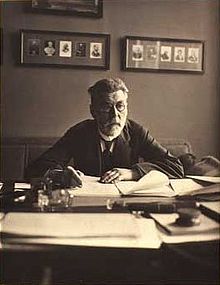Danish civil engineer From Wikipedia, the free encyclopedia
Asger Skovgaard Ostenfeld (13 October 1866 – 23 September 1931) was a Danish civil engineer who specialized in the theory of steel and reinforced concrete structures. He is now considered to be the founding father of the theory of structures in Denmark.

Ostenfeld was born in Hvirring near Horsens in Jutland in 1866. From 1900, he was professor of applied mechanics and steel structures at the Technical University of Denmark. In 1894, he designed the Langelinie Bridge at Østerport Station which at the time was the largest structure in Denmark built by a Danish engineer. In 1926, he was instrumental in creating Denmark's first Theory of Structures Laboratory which he later directed. Ostenfeld published a number of textbooks on the theory of structure which were widely read outside Denmark.[1]
Around 1920, Ostenfeld extended Axel Bendixsen's method of deformations together with the force method creating the dual concept of the method of deformations. His method represented significant progress in that "it enables previously analysed structural elements so to speak, to be built on". This is achieved through the introduction of rigidly fixed members for the obstruction of joint rotations. It allows the complete frame to be divided into finite elements.
Also contributions to Danish and foreign journals on Deformationsmetode, Aabne Broers Sidestivhed, Beregning af Søjler.
Seamless Wikipedia browsing. On steroids.